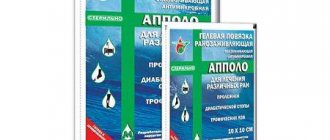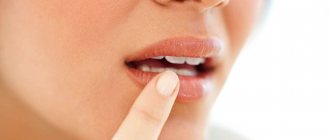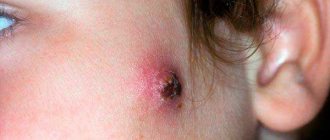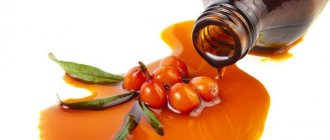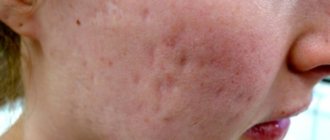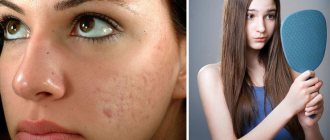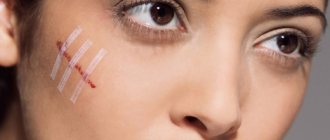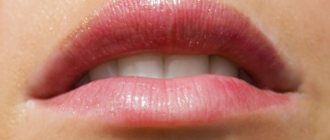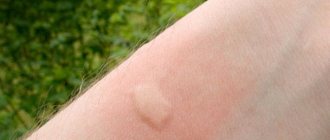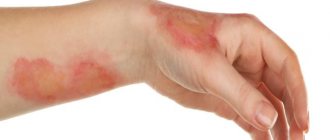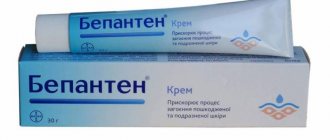Burn injuries, regardless of the degree and location, are unpleasant and painful. At a significant level of severity, the injury can bother you for a long time and leave scars and age spots. The burn mark after minor injuries goes away quite quickly, but with more serious injuries it is not so simple.
It is better to learn from your treating specialist how to remove redness from a burn on the face, hands, and other parts of the body using home remedies and cosmetics.
Causes
There are a number of factors that provoke the formation of negative consequences:
- Lesions after thermal, chemical injuries cause red marks on the skin. This is pigmentation that may go away over time. The younger the body, the faster the burn mark goes away.
- Depending on what you apply to the problem area and the degree of redness, pigmentation may go away in a year or longer. Improper treatment can lead to scarring and burn marks.
- Sun and radiation damage cause white and brown marks on the skin. White skin from a burn can last quite a long time. Often this problem is caused by a burn after laser treatment.
- Damage caused by celandine, iodine, salicylic acid provokes the formation of brown spots, dark red or burgundy.
All burn stains can be eliminated with the help of medications, folk recipes, and hardware cosmetology.
What can you do at home?
Various home methods will not help remove long-term marks and scars after burns, but they may well come to the rescue if the skin has simply darkened. To help eliminate pigmentation:
- Acid. Peel the cucumber and tomato, puree them with a blender and apply the resulting pulp to the darkened areas for 15 minutes. Thanks to the presence of acids, such a simple mask will somewhat lighten the spots and help even out the skin texture.
- Lemon. This fruit has been used for skin lightening for many years. To achieve a therapeutic effect, you can simply wipe the darkened areas with its pulp.
- Jojoba oil. Wipe burn marks with it twice a day.
- Parsley. Chop the greens and brew with boiling water. Use a glass of water for a handful of parsley. Boil in a water bath for a quarter of an hour, then strain. Soak a cotton pad or gauze pad in the broth and apply it like a compress to the problem area.
- Beeswax. Grate 50 g of wax, place 100 ml of olive oil in a water bath. Once the oil is hot, pour the wax into it and let it dissolve, stirring constantly. Apply the cooled medicine to a cloth and apply to the affected area overnight.
Some home remedies work as effectively as advertised medications. But not a single method of alternative medicine will help smooth out scars.
source
How long does pigmentation last?
Red and white pigmentation can last from several days to a year or more.
The following time limits are standard:
- Minor problems caused by thermal, chemical injuries last about 3-5 days;
- Pigmentation after a burn with UV rays lasts approximately 3-7 days;
- Traces after grade 2 lesions can be eliminated in 10-20 days. Medicines, alternative medicine recipes, and possibly surgery will help remove redness;
- If the wound is infected, the pigmentation goes away after a few months;
- Grade 3 injuries drag on for a very long time, leaving red spots, most often for life.
To prevent the occurrence of such a problem, you need to undertake effective and timely treatment, and then ask your doctor how to remove burn marks at home.
How to treat if there is an inflammatory process after a burn? Tablets and local remedies
After burns, regeneration is slow, leaving scars, scars and pigmentation. In order for healing to proceed faster and no trace left at the site of injury, a whole range of restorative and rehabilitation procedures is necessary.
How should it heal?
Incorrect treatment and improper care always lead to complications even with mild, household burns. Each degree of damage has its own time frame for healing.
With redness and slight swelling, the symptoms gradually disappear on the 5th day. The wound does not require special treatment; rinsing with cool water and treating with special ointments is sufficient.
For 2nd degree burns with the formation of blisters, healing begins from the moment they spontaneously open and form a yellow-gray scab at this site. With properly selected treatment, the uncomplicated process begins on days 4–5 and ends by day 10. An inconspicuous scar remains in place. With spontaneous healing, the period extends to 14–20 days, with the formation of a scar.
With grade 3 lesions, when the wound surface is not only on the skin, but also on the subcutaneous tissue, spontaneous healing is impossible. With proper treatment, by the end of 10 days a scab will form at the site of the injury, but healing will occur within 2 months. Deep scars remain on the body.
Recovery from 4th degree burns with charring of soft tissues, bones and joints takes years.
The speed of healing depends on two factors:
- Square. Small burns recover faster.
- Traumatic source. Wounds heal better after exposure to steam than from flame or chemical agents.
Possible complications
Normally, the physiological healing process goes through three phases and is a chain of biological reactions.
There is an inflammatory process in progress
This is the first stage of healing. Inflammation begins immediately after the burn and, if there are no complications, lasts up to 5 days. A typical reaction occurs - narrowing and subsequent dilatation of blood vessels, exudation and infiltration.
For local treatment in this phase of inflammation, drugs with antiseptics, enzymes and osmotically active substances are used.
They must solve 3 problems:
- Cleanse damaged skin of dead cells. Open the infected blister.
- Prevent suppuration.
- Create conditions for the formation of a new epidermis.
To ensure that the inflammatory process occurs physiologically and without complications, hydrophilic (polyethylene glycol) or emulsion-based products are applied to the affected areas. They adsorb toxins, do not dry out the wound and do not allow the dressing to dry out. At the first stage, it is important to ensure access of oxygen to the burn site, and products that form a greasy film prevent this.
The wound is festering
Primary bacterial infection most often occurs on the 3rd day after the burn.
A huge number of leukocytes and lymphocytes accumulate in the wound. The surface of the burn becomes covered with pus - a natural reaction of the immune system to fight pyogenic microbes.
At a later date, with improper treatment or insufficient care, a new focus of necrosis (secondary infection) may form. Suppuration is always accompanied by general intoxication, pain, and fever.
Covered with a thick crust
For uninfected 2nd degree burns, a crust (eschar) forms on days 3–7, under which active healing and the formation of new, healthy skin take place. This type of healing does not occur under gauze bandages; a crust forms only when air is exposed.
A scab is a natural, natural “bandage” that protects the wound from bacteria, dirt and injury. It stays on the wound until healing occurs. After young epidermis appears at the burn site, the scab gradually peels off and comes off on its own.
What to do?
If the burn has festered, it is necessary to use emulsion or hydrophilic based products. Fatty ointments do not drain the wound, but create an additional and undesirable “greenhouse effect”.
Experts also do not recommend applying them due to the fact that they disrupt the natural outflow of wound fluid and increase intoxication. Fat-based ointments are indicated for epithelization or granulation, i.e.
at the third stage.
External anti-inflammatory agents on a hydrophilic basis:
- Levosin is a multicomponent ointment with sulfadimethoxine, methyluracil, trimecaine and choramphenical. Antibiotic and chemotherapeutic components have antimicrobial, anti-inflammatory, necrolytic and analgesic effects.
- Levomekol is a multicomponent ointment with methyluracil and chloramphenicol. Has an antimicrobial and restorative effect.
- Dioxidine ointment is an external agent based on dioxidine, nipagin with a pronounced antibacterial effect.
- A 0.2% aqueous solution of quinosol is a low-toxic antiseptic.
External emulsion-based products:
- Syntomycin liniment is a local antimicrobial drug with high broad-spectrum activity.
- Dermazin (cream) with silver sulfadiosine. It has a chemotherapeutic and antimicrobial effect.
After 5–7 days, it is recommended to change medications and start using restorative ointments.
For redness and swelling, products with bactericidal and healing properties are used:
- Povignon-Iodine solution;
- Panthenol spray;
- balm Rescuer;
- Kvotlan ointment;
- gels Burns Net, Apollo;
- Acerbine;
- Olazol.
The products have a disinfecting effect and heal the epidermis.
How to treat with tablets?
After a burn, during the first three days, therapy includes painkillers and anti-inflammatory drugs orally.
Drug groups:
- Combined analgesics Spazmalgon, Trigan-D, Pentalgin, Tempalgin.
- Non-steroidal anti-inflammatory drugs Ibuprofen, Ketoprofen, Nimesulide, Diclofenac.
For recovery after a burn injury, vitamin preparations (groups A, B, C, E) will be prescribed.
What to apply?
In the epithelization phase, new, young skin is formed. To speed up regeneration and prevent scars, other groups of drugs are included.
Ointments for regeneration
Solcoseryl is considered one of the best products with good restorative abilities. It is available in ointment, cream and gel.
Properties of the drug:
- Creates a protective film on the surface of the wound.
- Stimulates collagen synthesis.
- Accelerates cell growth in the upper layer of the epidermis.
Before applying the product, the surface of the wound is treated with an antiseptic solution. After Solcoseryl is applied in a thin layer to the entire surface of the burn in the morning and evening. The course of treatment is from 2 to 8 weeks.
Algofin forte and Actovegin also have good regenerating properties.
Recovery creams
Poor wound care for burn patients can result in physical discomfort or aesthetic problems.
There are several types of scars:
- Normotrophic. Almost blends with skin tone.
- Atrophic. They look like indentations.
- Hypertrophic or keloid. They differ from the skin in color and structure and rise above it.
After the surface of the burn has healed, the restorative stage of treatment begins. Its task is to prevent atrophy or hypertrophy. For this you need anti-scarring ointments.
List of the most popular:
- Contractubex is a gel based on heparin, allantoin and onion extract. Improves blood microcirculation and prevents the growth of connective tissue.
- Imoferase. Hyaluronidase cream smoothes scars and scars, inhibits pigmentation and increases elasticity.
- Heparin ointment. Used as a prophylactic against connective tissue growths.
- Kelo-cote gel. Effective for atrophic, hypertrophic scars. It is completely safe, therefore it is approved for treating children.
All restorative creams are applied with massaging movements to clean, dry skin in the morning and evening. Minimum course – 2 weeks.
If a crust has formed
If infected, the scab ceases to play a protective role. On the contrary, it creates a barrier to the spontaneous release of pus from the wound. The surrounding tissues become inflamed and swollen. Therefore, in such cases, the crust is soaked with antiseptics and carefully removed. Treatment solutions:
- Miramistin;
- Hydrogen peroxide;
- Chlorhexidine;
- Furacilin.
Folk remedies
A burn is a serious injury, so home methods can only be treated at stages 1 and 2.
What to apply:
- gruel of raw potatoes;
- black tea infusion;
- linden decoction.
Honey is considered the most effective in treating burns at home. It is used both independently and with other components:
- Honey and chopped raw potatoes (3:1).
- Honey and aloe juice (1:1).
- Honey and pumpkin juice (2:1).
Surgical treatment of suppuration
Primary or secondary infection requires opening, removal of pus, followed by passive or active drainage.
There are two types of surgical treatment:
- Necrotomy. The essence of the operation is the longitudinal dissection of the scab to the entire depth of the wound. The procedure is necessary in order to prevent circular necrosis - compression and circulatory impairment under a large burn scab.
- Necroectomy is a step-by-step and layer-by-layer removal of pus and dead tissue from the wound surface to a viable bottom. Basically, this operation serves as a preparatory stage before transplantation.
Treatment of suppuration can be early (several days after the burn) and late (2 weeks after a secondary infection). The surgical procedure is performed only in a hospital setting.
Rehabilitation after burn injury
When the wound surface becomes closed, the recovery stage begins. It includes physiotherapy, sanatorium treatment and psychological assistance.
For injuries on the body
Rehabilitation minimizes residual effects after burns and allows the victim to return to normal life. A course of restorative physiotherapy is indicated for extensive superficial and deep lesions, keloid and hypertrophic scars and after reconstructive operations.
Procedures:
- Ultraviolet irradiation for regeneration and stimulation of the immune system.
- Electrotherapy for pain relief, improving blood circulation.
- Ultrasound and phonophoresis for scar resorption.
- Laser therapy to stimulate regeneration.
How to restore your face?
Burns on open areas of the body inevitably become a psychologically traumatic factor in almost 70% of victims. For burns on the face, this figure approaches 100% and leads to serious post-traumatic stress disorder. Such patients are indicated for psychotherapeutic assistance and specialist support for one to two years.
How to remove a burn?
Using local medications, pigmentary changes can be eliminated. If the damage has affected the deep layers of the epidermis, recovery will be difficult, and the spots will most likely remain.
Drug therapy
Complications resulting from grade 1-2 lesions resolve after a month of effective treatment:
- How to smear burn marks to eliminate them as quickly as possible? Contractubex is a highly effective product whose active components act on the deep layers of the skin. Using the gel regularly, you can achieve good results.
- Solcoseryl will help whiten the skin after a burn; it is characterized not only by healing, but also by anti-inflammatory properties, softens and whitens. In addition, the drug enriches cells with glucose and oxygen and stimulates the production of granular tissue. Recommended by specialists for complex and severe injuries.
- Actovegin is able to remove redness after a burn - an ointment that stimulates the metabolic process in tissues, restores and normalizes skin tone.
- Mederma is an excellent ointment against burn marks, developed on the basis of cepalin and allantoin. These elements eliminate skin pigmentation, soften, restore tone, and are suitable if you need to eliminate a dark old spot after a burn.
- Panthenol is a popular drug used to treat thermal injuries, relieve redness, and remove burn marks. This is due to the presence of pantothenic acid, which accelerates regeneration processes.
- Bepantel reliably fights damaged tissues, stimulates the active growth of new healthy cells, and normalizes the epidermis.
- Fermenkol gel improves the cell renewal process, eliminates defects, normalizes pigmentation, and helps whiten the skin after a burn.
Important! An effective method of dealing with complications - bandages with silicone "Mepiform" - help get rid of the problem in the shortest possible time. A special coating with silicone ensures high elasticity of the skin, restoration of color and structure of the skin.
How to get rid of a burn mark using hardware methods
For pigmentation of deep injuries, you will need qualified assistance from dermatologists and well-chosen hardware procedures:
- Deep peeling on damaged tissues allows you to quickly start the process of epidermis renewal;
- A cosmetologist will tell you what to do if your skin darkens after a burn and recommend an effective procedure. Creotherapy with liquid nitrogen stimulates metabolic processes in tissues, improves blood supply to the damaged area;
- Laser treatment is an alternative therapy that has a restorative effect on tissue;
- What can be done if red spots remain after a burn? Phototherapy eliminates inflammation and renews epidermal cells.
- Mesotherapy is based on the effect of light flux, which improves blood flow and normalizes skin pigmentation. The technique helps to remove pink skin after a burn in 1-2 times. If all of the above methods do not work, resort to aesthetic surgery methods.
How to quickly remove redness from your face after sunbathing - 10 tips
A light tan has always been considered beautiful, because it gives the skin a healthy tint. But sometimes you can overdo it with the time spent in the sun, which will certainly cause burns.
In this case, after a few hours, redness will certainly appear, which will be accompanied by unpleasant sensations.
Then you need to figure out how to quickly remove redness from your face after tanning at home, so that the burn does not lead to unpleasant consequences.
Why does the skin turn red?
First of all, you need to figure out why the dermis turns red and burns after prolonged sunbathing. In this case, redness is a skin reaction to a sunburn, which can sometimes be accompanied by pain and itching.
Also, if the skin on the face is very sensitive, blisters may appear , which will significantly worsen the situation.
In addition, at the site of the burn, the facial skin often has an increased temperature, which is explained by the fact that the body is trying to heal itself.
The redness usually goes away on its own after a few days. But most people are not ready to wait that long, because the wait is painful, and the skin of the face suffers. In this case, you should not be disappointed, because redness can be removed in 1 day .
First aid for sunburn
In the event that little time has passed since the detection of redness in the face, then first aid should be provided.
If you have aloe at home, then you need to cut off one leaf of this flower, and then cut it lengthwise and wipe the burn area on your face. Thanks to its beneficial components, the redness should go away the next day.
In the case where there is no aloe in the apartment, then fermented milk products will come to the rescue. Kefir is perfect for these purposes.
To use them, you need to apply a small layer of any fermented milk product to your face, and then give the product time to dry.
You should pay attention to the fact that you should wash off kefir from your face only with running water without using aggressive detergents.
How to remove redness on the face after sunbathing using special products
To remove facial redness, you can resort to using one of several effective methods of getting rid of a burn, among which the most popular are masks, ointments, compresses and creams.
Compresses
Compresses are considered one of the gentle methods of getting rid of thermal burns on the face. They can be made with various herbal decoctions , as well as the juice of vegetables and fruits. The most effective methods are described in the table below.
| Name | Recipe |
| Green tea compress | You need to brew strong tea and then add a few drops of aloe juice. Afterwards, you need to apply it to your face using gauze or any other fabric for a quarter of an hour. |
| Chamomile decoction compress | To prepare it, you need to brew 1 spoon of dried flowers in a cup of water. Then cool and apply compresses with a towel for about 15 minutes. |
| Parsley decoction compress | Brew several bunches of green parsley in 250 ml of water. Afterwards you need to leave it to infuse in a cool place for about an hour. Then apply the finished product onto the face using a gauze cloth. |
Masks
An excellent way to eliminate the consequences of a burn is a face mask. It can be prepared from any available ingredients in the kitchen . Another advantage of using this method is the distribution of minimal costs for its preparation. Recipes for the best masks are below.
| Name | Recipe |
| Cucumber mask | It’s quite simple to prepare: you need to grind it on a fine grater until it becomes mushy, along with the peel. Then spread the resulting mixture evenly onto the surface of the skin. After 15 minutes, you can rinse with warm water. |
| Potato mask | For cooking you will need 1 peeled potato. It must be crushed in a blender and then applied to the face. Keep the mixture on the skin for at least 15 minutes. |
Ointments
Ointments against redness on the face should be prepared using various herbal decoctions that are aimed at relieving inflammation, as well as accelerating the regeneration process. Fats are also added to their composition. They can be of both plant and animal origin .
But it should be noted that the victim should not use such products, as they clog the skin, which increases the likelihood that during the process of healing the skin and removing redness on the face, the skin may simply peel off . Therefore, you should not apply any cream or ointment to the burn site.
Creams
Considering the information presented above, it should be concluded that homemade after-sun cream is not the best option for relieving facial redness. In this case, it is necessary to give preference to various compresses and masks . You can also resort to the help of proven pharmaceutical products.
How to remove redness from the face after sunbathing at home
The simplest method of removing redness on the face is considered to be the use of pharmaceutical products, most of which consist of panthenol. This substance helps restore the skin to its usual appearance.
Also, in addition to sprays, ointments can be used. Among them, the “ Rescuer ” ointment should be highlighted.
Unlike imported products, it is not expensive, and the effect will be noticeable after the first use.
Few people know that you can remove redness on your face with regular vodka . Unlike other folk remedies, it prevents the skin from dying, which is why the skin will not peel off.
It also has the ability to cool the skin, so after sunbathing it can relieve pain from a burn.
But you need to be careful that this method is contraindicated for people with dry skin , since vodka can easily dry out the skin.
An equally effective way is to remove redness using lemon . The juice of half a lemon must be mixed with one egg white, and then add a spoonful of honey to the mixture.
The resulting product can be used up to 3 times a day. It is not recommended to use this method more often because the skin will become very sensitive and dry.
Keep this mask on your face for at least 10 minutes.
Pharmacy products
The most common and common mistake in the use of pharmaceutical products for sunburn burns is ignorance of the functions and purpose of the drug.
Pharmacies offer a lot of different drugs, some of which relieve pain, while others moisturize and start the process of regeneration of the skin.
Before purchasing any pharmaceutical product, you should understand the composition of the drug, and also pay attention to the active ingredients:
- Hydrocortisone is one of the most important hormones that is secreted in the adrenal cortex. It is responsible for the exchange of incoming proteins and carbohydrates. Drugs containing this substance are aimed at reducing the level of pain. The products can also help remove facial swelling.
- Panthenol is considered the most common substance that is added to almost all anti-sunburn products. But few people know that panthenol is a common vitamin that is responsible for cell regeneration. Most drugs in the world do not contain more than 5% panthenol. Thanks to this combination of elements, the skin using these preparations does not crack or peel.
- Analgesics are one of the pain-relieving substances that help with redness. NSAIDs are also popular, which eliminate the inflammatory process of the dermis.
Removing redness using regular products
In the case when the dermis on the face turns red, then ordinary products from the refrigerator will come to the rescue. Indoor plants and even candles can also help . The main thing is to know how to apply it correctly:
- Aloe juice is the only indoor plant that is used not only to treat viral diseases, but also to relieve facial burns. Its anti-inflammatory components have a gentle effect on the victim’s dermis, thereby preventing pain from increasing.
- Olive oil helps only if it is first cold pressed. The oil should be wiped over the skin area at night before going to bed.
- Sea buckthorn - to remove redness, you only need the juice of this berry. It softens and nourishes the skin well.
- Sour cream is the most popular method for sunburn. You can replace it with homemade kefir. Dairy products have a good effect on the condition of the skin. After use, body temperature will immediately decrease and pain will go away.
- Clay – green or white is best. Dilute it with plain water until it becomes mushy. To relieve redness, apply the clay mixture to your face and then wait until it dries completely.
- Paraffin – for use it is necessary to purchase medical paraffin. It is inexpensive, and the effect is amazing. The drug must be applied to the skin using a cotton pad, and then wait for the paraffin to cool.
Some tips on how to protect your skin from the sun
Everyone knows that it takes a very long time for redness to go away. This will take more than a day. Therefore, it is better to think about preventing the appearance of redness on the face. To do this, experienced dermatologists have prepared several tips for preventing facial redness:
- Do not visit the beach from 11:00 to 16:00 due to the fact that at this time ultraviolet rays most aggressively affect the dermis.
- Tan gradually , increasing your time in the sun by 10 minutes every day.
- Use sunscreen , which will prevent not only facial burns, but also premature aging of the skin. How to choose a sunscreen can be found here.
- Minimize time spent in direct sunlight.
What you should never do if you have burns
- It is strictly forbidden to use fat-containing products .
This applies to various ointments and creams. You should also not use Vaseline. Such products can increase body temperature in a very short time, which is why the skin will need more time to regenerate. Also, creams do not allow the skin to breathe fully. - Under no circumstances should you exfoliate your face .
You need to wait for the skin to completely heal. Before that, they only traumatize her. - to wear makeup during facial treatment , as cosmetics do not allow the skin to recover. After applying makeup, it may begin to peel off.
- Do not visit the solarium or the beach until the redness from your face is completely removed. Repeated visits to sunbathing will only worsen the situation.
How to temporarily cover up a red face
If the redness of the face is slight and does not cause pain when touching the skin, then the use of cosmetics is allowed, but only without foundation.
To do this, you will need a regular concealer , which is in any cosmetic bag. You can also use fluid . In some cases, color correctors , among which green and yellow are the best colors.
-adviсe
Tanned skin always looks very good, but only when it is a light bronze shade, and not red, like boiled crayfish.
When such a nuisance as a burn to the face occurs, you cannot waste precious minutes trying to save yourself. In this case, it is necessary to use not only folk remedies, but also resort to the help of pharmaceutical drugs.
Cleverly selected treatment will have a positive effect on the condition of the skin, and facial redness will go away in a matter of hours.
Source: https://fitolico.com/kak-bystro-ubrat-krasnotu-s-litsa-posle-zagara/
How to get rid of a stain after a burn using traditional medicine recipes
Using proven methods that have been proven since ancient times, you can cope with redness:
- Fresh urine from children is used for dressings and compresses;
- How to remove a mark on your hand after a burn if the injury is minor? It is recommended to wash the injured area with cold black tea;
- Castor oil helps remove pink skin after a burn;
- Aloe juice - applied in the form of compresses, applications;
- Lemon juice helps to whiten spots on the face after a burn;
- Chopped raw potatoes should be kept on the wound for 20-30 minutes a day to whiten the reddened area;
- Crushed gruel from fresh burdock leaves is applied if there is redness around the burn;
- If the skin has darkened, sea buckthorn oil helps effectively, the liquid heals and restores the color of the epidermis;
- Cabbage juice helps get rid of not only swelling and inflammation, but also new spots.
To combat age spots and marks, you need to use special gels and creams daily in combination with traditional methods of treatment.
Treatment of old scars on the face and body
Eliminating long-standing scars on the skin that remain after burns can be very, very difficult. However, the following will help you cope with this task:
- Medications.
- Modern cosmetological methods.
- Surgical interventions.
An experienced cosmetologist will help you choose the most suitable option for getting rid of scarred skin changes. The doctor can offer an effective treatment regimen developed on an individual basis.
Creams and ointments
To treat scars on the skin, it is most often recommended to use:
- Contractubex. This is one of the most famous drugs for treating scars. It contains allantoin, which can stimulate regenerative processes and dissolve damaged tissue areas, as well as Serae onion extract, which eliminates inflammation and slows down the growth of connective tissues. The ointment also contains sodium heparin, which softens the scar. The product should be applied up to 3 times a day.
- Dermatix. This is a gel that effectively retains moisture in the skin, helping to smooth and soften scars. The manufacturer claims that this product also copes with pigmentation disorders and eliminates the feeling of discomfort.
- Clearvin. This is a natural-based cream, developed according to the recipes of ancient Indian healers. It is believed that its use helps make scars less noticeable, as well as eliminate pigmentation on the affected skin. The components of the cream penetrate remarkably deep into the skin, optimize its filling with oxygen and slow down the formation of melanin.
- Epitonex. This cream also has a natural composition; its use can improve blood circulation in the skin, soften and moisturize the epidermis, nourish it and stimulate regenerative processes.
- Kelofibrase. This is a fairly effective cream with urea, sodium heparinate and camphor, which perfectly stimulates regeneration, improves blood circulation and reduces the tightening effect.
- Fermenkol. This is a gel that contains a number of animal enzymes that can break down collagen (which scar tissue is made of). Manufacturers claim that the medicine acts only on pathological scars, without destroying healthy tissue.
You shouldn't expect miracles from medications - they only work well on fresh scars. In the case of old scars, they will only slightly reduce them, but will not be able to completely eliminate such marks on the body.
Professional removal
To remove scars on the body, cosmetologists and dermatologists can offer:
- Laser peeling. This method allows you to get rid of scars even on open areas of the body, including the face. Cosmetologists claim that laser peeling is painless and absolutely safe. The laser beam is able to eliminate scar cells, smooth out the scar and make it almost invisible.
- Chemical peeling. In this case, the skin is affected by fruit acid compounds. They whiten and smooth the skin, and also soften the scar. Deep peelings help launch the repair mechanisms of skin cells, activate collagen synthesis and reduce scars to a minimum. Sometimes peelings are recommended to be performed in a course.
- Diamond grinding. It is believed that this method can eliminate even quite old and large burn scars. But after resurfacing, the patient still needs to recover properly for some time for the procedure to give the expected effect.
- Glucocorticoid injections. When performing this procedure, the doctor injects hormones directly into problem areas.
- Removal of scar tissue. Sometimes doctors recommend simply cutting out the scar and placing a cosmetic suture in its place. As a result, only a barely noticeable thread-like mark will remain on the skin, which can be made almost invisible with the help of creams and ointments.
